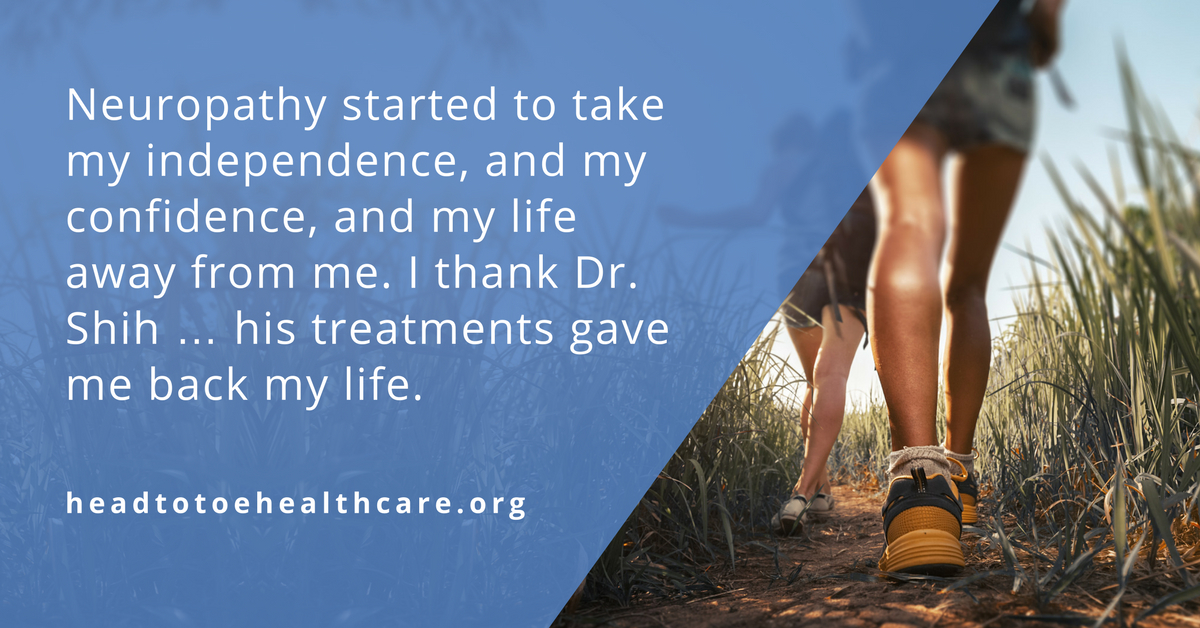Relief From Neuropathy: Making The Impossible Possible
Millions of Americans struggle each day with the effects of peripheral neuropathy in the feet and legs. For some, the condition causes chronic aching or severe, stabbing pain. Others experience muscle weakness and loss of balance. Many simply lose sensation entirely, putting them at high risk of injury.
But the symptoms themselves are secondary. The real problem is how peripheral neuropathy disrupts people’s lives and robs them of their independence. You might lose the ability to walk more than short distances. You might have to give up driving, because you can’t feel the pedals. Sleep disturbances are common and can cause to lose focus or emotional control. Going shopping, playing with kids and grandkids, traveling, running, hiking—you may find these activities and more become increasingly difficult, if not impossible.
Nowhere to Turn
Unfortunately, even today, quality treatment for neuropathy is not easy to find. For decades, most physicians told their patients that little could be done to reverse their symptoms or restore healthy nerve function. Injections and medications might be prescribed to manage pain or discomfort, but that was about it.
In recent years, more advanced treatment options have become available. But real relief remains elusive for many. Every day, we meet frustrated patients sick of visiting doctor after doctor for treatments that don’t work.
“I’ve had neuropathy for approximately 8 years,” said Gerry. “I’ve had several doctors try to treat it, and mainly they’ve been running EMGs, checking the nerves, and then treat me with medication. My feet were getting numb and tingly, and I couldn’t walk on them too well anymore.”
But thankfully, that’s not where the story ends.
Pushing the Boundaries of What’s Possible
Contrary to what you may have heard, treatment for peripheral neuropathy is possible—not just symptom management, but treatments that target the root causes and bring lasting improvement to nerve function in the feet.
Here’s what it comes down to:
- Specialized training and knowledge. Nerve anatomy is highly complex, and really requires years of in-depth training to fully understand and appreciate. Physicians who are not nerve specialists may have difficulty diagnosing the correct condition or applying injections or other treatments in the right location. That doesn’t mean they’re bad doctors! It just means they might not have the correct training for your diagnosis. You wouldn’t go to a nephrologist to fix your eyes, and you wouldn’t go to an optometrist (even our excellent Dr. Zainalabidin) to fix your kidneys! Dr. Alan Shih is a foot and ankle neuropathy specialists, and one of only around 220 surgeons worldwide to study peripheral nerve surgery at the Dellon Institute.
- Comprehensive and advanced treatment options. The field of medicine is always changing. In order to continue to provide the best outcomes for their patients, doctors must offer the widest range of treatment options and invest in the latest technology, research, and training to stay ahead of the curve. Any doctor can offer you injections or medicine for your nerve problem. Fewer can offer MLS laser therapy as part of the treatment. Fewer still possess resources like radiofrequency nerve ablation (we’re one of just a few in the entire state) or nerve decompression surgery.
- A personalized approach. Every person who visits our office is unique. Different symptoms. Different location and severity of their condition, even if the diagnosis is the same. Different lifestyle and activity goals. Even if you have the best training and tools, you still need to personalize the treatment to best meet the needs of each patient. There are no one-size-fits-all solutions to peripheral neuropathy. We’ll do everything we can to treat you right, as simply and effectively as possible.
Real People, Real Stories
What does that look like in practice? For Bruce, who had been suffering from neuropathic pain and muscle weakness for almost 8 years, the answer was surgery.
“After seeing four different foot doctors over the years and getting several orthotics, I still had pain,” he said. “The shoe inserts helped, but did not fix the problem.” Bruce loves the outdoors and was only 40 years old when the problems began, so neuropathy had slowly taken away his ability to stay active with hobbies he enjoyed. “After the surgery, I can wear any shoe type and do any activity I want,” he continued. “I am 48 years old and I hike long and hard now. Thank you!”
How about Marie? After we diagnosed her with neuropathy and talked with her about her symptoms and goals, we recommended laser therapy. “I decided to go ahead and do it,” she said. “It has helped tremendously. I don’t have nearly as much pain as I used to.”
The results have been incredible for Gerry, too. She spoke with us to report her results after only six weeks of treatment sessions.
“I went from walking on my tippy toes and broken glass and rocks,” she said. “Within the first treatment I could wiggle my toes. Within 2-3 treatments I was walking flat on my feet. The majority of the pain and weakness is gone. My toes aren’t ice cold anymore. I can walk longer periods of time.”
Gerry said she was driving again and planning to take her grandson to the park and do more travelling—all activities that she had been unable to perform for years due to her condition.
“Thank you so much for giving me back my life.”
Success is in Your Story
Are you living with peripheral neuropathy? Have you been to doctor after doctor without success? Give Head to Toe Healthcare, PLC a call today at (520) 545-0202. Let us help you get your life back, too.
Contact Us
Office Hours:
Monday - Friday
8:00AM - 5:00PM
Tucson Foot & Ankle Institute:
7406 N. La Cholla Blvd.
Tucson, AZ 85741
Phone: (520) 545-0202
Fax: (520) 545-0201
© Tucson Foot and Ankle Institute. All Rights Reserved. | Privacy Policy


